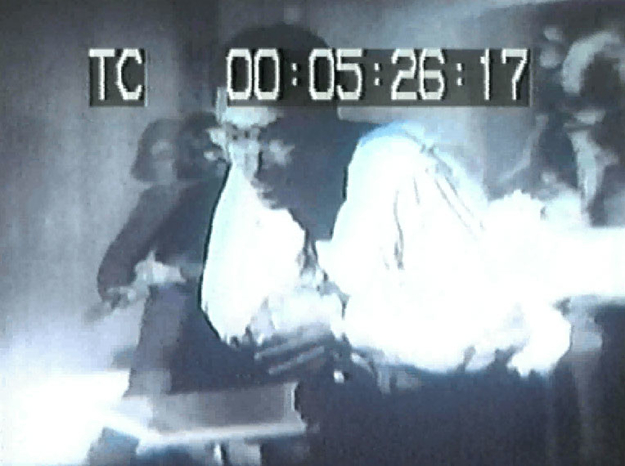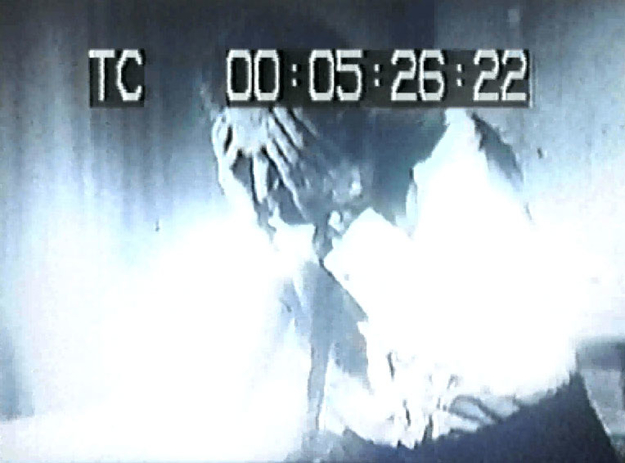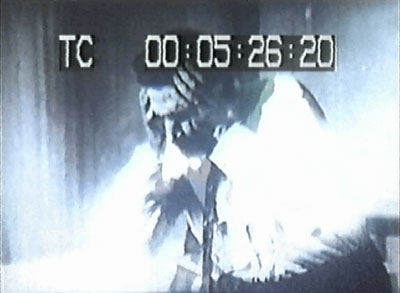In a sense, this CD-ROM covers a wide area in which we grope our way through an elaborate drawing by Ter Heijne, using the mouse for navigation. It's digital paper - or wishes to appear as such - its forms outlined in an almost baroque hand. Letters, texts, clouds, characters - until suddenly, almost as in some ancient palimpsest, we scrape through the surface. This searching and groping is accompanied by two alternating voices: One that of the objective observer, a neutrally affective voice of a female who sums up the factual information behind a number of suicides, the other the testimony of a desperate male victim, almost like a character out of one of Dostoevsky's novels: What kind of world is this when a madman has to tell you to be ashamed of yourself? Stumbling upon a hot spot, we are suddenly confronted with video footage of several suicides - suddenly indeed, but the cursor warns us in time: here, don't be scared, you can still close your eyes or quickly pull away.
The subjectivity of Ter Heijne's drawings, leaving some space for the mechanical truth of the movie clips, makes it clear from the start: Beauty is only skin deep. Literally right behind the drawing - almost made as if on handmade paper - are the video stills of suicide actions. One click away was never far away, but this is a very sharp transition indeed. Ter Heijne's interface almost literally lets the videos break apart from the drawing and onto the screen, giving a sudden realistic turn to the softer drawing itself; a reflection it seems of the contrast between the female voice's objectivity and the male voice's crude complaints, with the female voice closely related to the softer drawings and the mournful male voice to the raw film footage. But then doubt sets in: are the 'objective video stills' not far more subjective than the apparently subdued drawings? Because no matter how we first experience the transition from handwriting to film footage, the transition from what appears to be poetry to rough reality becomes less and less clear. The raw and blurry video images take on the paper's character, while the paper seems to possess certain qualities of video, and both seem to be affected by the tragic events they describe.
Suicide by fire, part of a fringe political culture until very recently, is now at the center of public opinion, as a form of suicide that has become both an image of sick crime and the object of religious devotion. Whoever dares to take a look at these videos can sometimes see the action being prepared, the panic surrounding the victim, the powerlessness when confronted with a burning body, the often helpless aid in the form of a bucket of water, the public fear as people rush to leave the scene, the result of a body that may be outwardly damaged but not yet dead.
Self-immolation, although an undeniable political and moral act, was once an individual sacrifice. Now it appears to be one of the most powerful political weapons of the new century. The artistic message whereby Ter Heijne manages to combine form and content in a way that is so relevant to our age is carefully timed. Her drawings and the videos 'contained' therein are extremely topical given the attack on New York's WTC and the war in Afghanistan. Their content, shocking enough by itself, has become both artistically and ideologically truly amazing.
Ashes to Ashes, Dust to Dust
With For a better World, Ter Heijne gets involved with the international debates after the attack on Manhattan's WTC. She never meant to, since the CD-ROM was already finished before the attacks ever took place, so for the sceptical viewer there does not have to be any immediate connection. But once you see her images, you are inevitably absorbed by those events. Hijackers who commit suicide to further a higher goal are now a major political theme, something Ter Heijne seems to have anticipated. In a topical and thought-provoking way, and much better and more penetrating than the daily media commentaries we are faced with, she responds almost directly to the question of what exactly drove the New York hijackers. For a better World offers a further context for the event and its resulting confusion. The images we see and the voices we hear are a reflection of the faces of the hijackers who attacked the WTC and shed new light on their emotional state. Through the voices and motivations of the individuals she has selected, Ter Heijne adds a baffling color that is sorely missing in the daily media spectacle on the drama of New York.
The media lend a rational argumentation to the topical world. In a semiobjective fashion, they portray the battle between the American culture of capitalistic production, which uses the free market as its ideological stage, and Islam's minimalist culture, which insists on submission to Allah before all else. For a better World provides an irrational visualization of the clash between these two worlds. Navigating through all those individual suicides puts even the collective events of Manhattan and Washington into a clearer perspective, as if though suddenly we acquire a deeper understanding of the religious fanatic's imagination.
For navigating among and listening to the cases presented by Ter Heijne, we are taken very close to the motivation of Bin Laden's self-made pilots. The battle between the secularized Western world and the ineradicable mythical aspects of human civilization slowly takes on relief. How can we trace their motives? One might say (and indeed most of us have said) that all those postmodernist scenarios by philosophers such as Baudrillard who claim that the virtual world has conquered the real world have been reduced to empty poetry by those burning skyscrapers. This is the poetic, aesthetic answer, betraying a tendency to see in the suicides an unmistakable philosophical and ancient poetic urge, as if the hijackers in their Boeings were apocalyptic avenging angels swooping down from heaven and crashing into the Twin Towers, their act of destruction the wrath of none other than God Himself if you like. As if the hijackers were poets, bringing the poetry of the ancient Greeks to life, lighting a fire of mythical secular proportions with their airplanes. Or perhaps one hears in their tale the voices of Arab storytellers from Damascus or Cairo - or from Florence. As if not the Qur'an, repository of God's dictates to Muhammad, but Dante Alighieri's Divine Comedy (itself heavily dependent on the Arab tradition) had formulated the hijacker's overpowering vision. And indeed, Dante's exhaustive description of his heavenly visions after his being granted a visit up above for his faithfulness to his lover following her untimely death, is an irresistible dream one would love to share. (That his dream is in fact irreconcilable with suicide - Dante himself accorded suicides a terrifying spot in hell - can be seen as a negligible detail in this context.)1
1For those who have undergone the power of the heavenly visions, there is simply no escape. Dante carefully prepares his vision in order to effect the apotheosis at his poem's finale. With a completely inward vision, seeing only what he wants to see, he knows himself surrounded by an infinite host of angels, strewn across the sky like shining sparks. Until finally, as by a single thunderbolt, he has a revelation of the ultimate view of paradise. The final lines of the Paradiso canticle of the Divine Comedy (XXXIII, 136-154) contain a highly suggestive description, almost like a command to the hijackers. At least Dante tells us that his own wings were powerless to accomplish this and that his spirit must be struck by a lightning bolt. Thus, he could make his desire and will revolve like a wheel and thereby acquire an understanding of Love, which moves the sun and all the stars. In this light, the heeling motion of the Boeing crashing into the WTC's second tower seems quite literally to have been the final step towards the revelation of the divine light.
It's an incredible idea that the hijackers realized their dream in part by using Microsoft's computer game Flight Simulator (fit for would-be pilots and stewardesses) and watching Hollywood disaster movies. One can hardly imagine how they must have used the game in their nightly sessions to stage all kinds of disastrous virtual flights around the globe in a Boeing's cockpit. They must have relished the dreamlike game of the failed pilot, unencumbered by real passengers and capable of every imaginable maneuver, only to live out their fantasy even further with some Hollywood disaster video. But as they set the WTC ablaze and reduced it to ashes with their overdose of kerosene, no Microsoft game nor Hollywood movie proved able to match that amount of reality.
But in Ter Heijne's reading, little is left of the suicide's possible mystical experience. She is not interested in the suicide's poetry. Against the hijackers who drag their passengers along in their religious fanaticism - without ever granting them a place in their paradisiacal world - this CD-ROM poses the abysmal reality of corporeal destruction. Against the titanic events in New York, that attack against the Towers of Babel, it presents us with images of the fragility of human existence.
Thanks to For a Better World, we become aware of a much deeper instinct in suicides. Ter Heijne elaborates on their circumstances; she offers explanations and presents the truth as such. She shows no interest at all in the possible poetry of a higher goal. She realizes that, at some point, every suicide will have to face the terrible truth. The frame in which she places them is an extremely ideological one, and utterly shocking, especially since a visual media critique as presented by her is quite unique.2
2 It is to be regretted that the powerful media critique to which filmmakers like Jean-Luc Godard and philosophers like Jean Baudrillard after him subjected the movie medium itself has never really been placed in the foreground in the digital world; or at least I am unaware of any recent bold statement such as that of Jean-Marie Straub, who, in the 1960's, could call his objectively speaking value-free movie on Bach a weapon in the struggle against American aggression in Vietnam. But especially on the Internet, contemporary digital developments are often exposed as ideological products. In the same way that in the sixties, everything seemed to be political (especially the cinema), there is a new realization that artistic video works almost by definition have a political dimension, including the tools that help to produce them.
She gets intensely involved with the political assimilation of all this digital material. The way in which she reduces her visuals alone makes one realize what naked realities surround these suicides. It is a horrible truth indeed. In the final instance, the suggestion of a heavenly light and the paradisiacal state they had hoped for turn out to be an unbearable inferno. Ashes to ashes, dust to dust.
Razor Sharp
Ter Heijne's quest for truth succeeds especially because of her utterly sober presentation. She uses QuickTime, but in a very modest way, almost as if to testify to her faithfulness to McLuhan's somewhat hackneyed, but apparently still highly topical maxim, the medium is the message. She does not fall back on the latest developments regarding QuickTime. Instead of relying on the controversial program nato.0+55+3d.Modular, she uses a program developed by Uwe Boek to play her videos in QuickTime, and in doing so, she arrives at a visual critique of digital visual culture that is rather less loud and ambiguous than that of nato.0+55+3d.Modular.3
3Using the name Netochka Nezvanova, a group of anonymous software programmers developed a program called nato.0+55+3d.Modular, a software package that makes intelligent use of the streaming possibilities in QuickTime. Though dependent on QuickTime, they are at the same time waging a cold war against it, denouncing it as a product of 'corporate fascists.' See also their web site: www.fiftyfifty.org/ffmedia/sans/nato.
Sharp as a razor, she dissects our need for ever better, nicer, clearer and more colorful images, in which all content is increasingly neglected. Ter Heijne doesn't formulate a critique on a medium, but within the very medium itself, as part of the work in question. She does not provide us with a clear opinion on the persons involved, whom I would call either victims of their own confusion or martyrs to some higher ideal. Ter Heijne's suicidal victims are not only stuck within themselves, in their thoughts and emotions, but in the video footage as well.
Ter Heijne takes us back to basics. That is to say that if, while navigating and clicking along, we stumble upon one of her suicide videos, it's a far cry from the lavish ambience promised us by QuickTime's latest version. These images give the impression that they have been copied over and over again; a visual atmosphere that in a way comments on the events on display and reaffirms the horror of the images themselves. One would rather not look at them at all; moreover, they seem to have been copied so many times that their visual quality is at times minimal at best. As if even the videos themselves, as visual carriers, resist them; as if they somehow want to rid themselves of their grisly contents.
And then, suddenly, the question forces itself upon us: are all these images actually real? For so detached is Ter Heijne's artistic and moral attitude - not once on the entire CD-ROM does she voice an opinion or question her own position - that it gives rise to a moral confusion, feeding such doubts. It is a moment of doubt that may be compared to what people experienced when they watched the attack on the Twin Towers: are these images of those burning towers, of that tilting plane crashing into the building - are they real? Are these objective images, or are they interspersed with fake videos?
Then you realize that those often blurred images of self-immolation, whose authenticity you were led to doubt for one moment, have been assembled here under the heading For a Better World.
And what lunatic would call that desire into question?
translation pieter bijker


